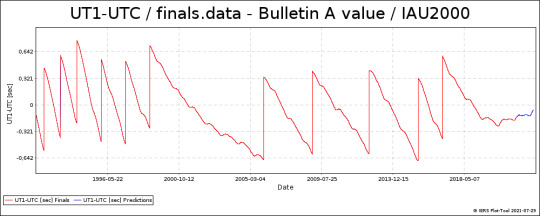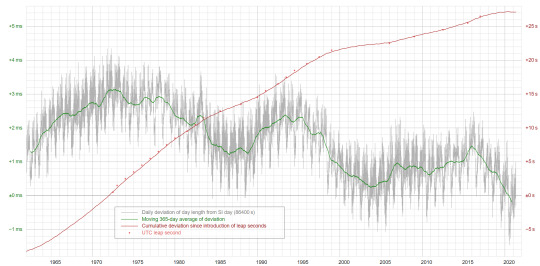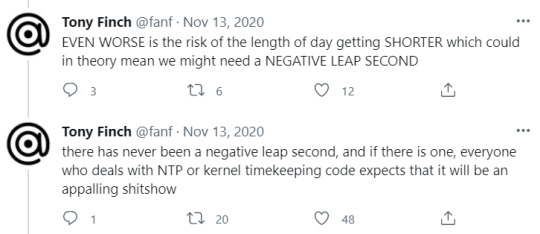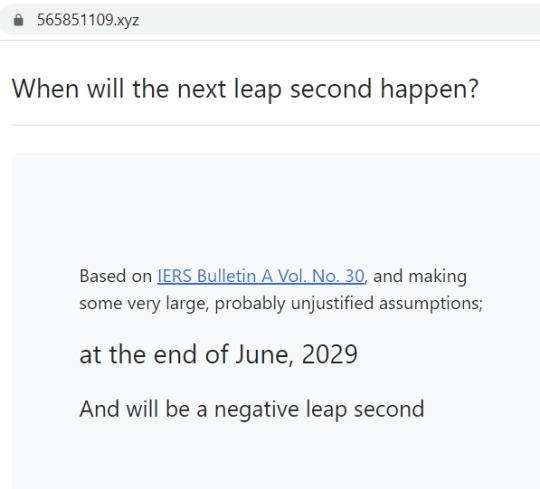#https://twitter.com/fanf/status/1327364308733472768
Explore tagged Tumblr posts
Text
an interesting thing I learned today was that global warming might result in a negative leap second sometime in the future

(admittedly the earth's rotation is affected by lots of complicated factors so it might not be that clear-cut, but anyway)
so you may be thinking 'but leap seconds are like a single second? so short! who's going to notice?'
well tbf the impact from these leap seconds is going to be most strongly felt by high precision things like GPS or NTP servers whatever (and the poor devs who have to maintain the software lol) but leap seconds have historically caused unexpected problems in financial markets and all sorts of websites and servers as well, so...
in any case, I find all this really fascinating and pls bear with me while I nerd out a bit about this :P
so normally speaking, the Earth's rotation should be gradually slowing, because the pull of tides from the Moon and so on (though there are other influences too, like fluid flow in the outer core, the movement of Earth's crust, etc. so it's all very complicated)
until recently, the length of a day has been about on average 1-2 milliseconds longer than 24 hours (note that there are seasonal variations though).
1-2 milliseconds may not seem like much, but it adds up over time!
in fact, it's the job of the IERS to monitor the difference between UTC (universal coordinated time) and earth's rotation angle (UT1), and decide when to insert a leap second to prevent them from drifting too far apart
the current version of UTC (as defined by the ITU) requires the difference between UTC and UT1 to be no greater than 0.9 seconds. The IERS typically inserts a leap second when the difference grows to 0.6 seconds.
HERE'S A GRAPH

see, the difference between UTC and Earth's actual rotation angle keeps drifting. UT1 keeps falling behind UTC, so those vertical lines are every time the IERS inserted a leap second, to bring UTC and UT1 back closer together
since UTC is ticking faster than UT1 bc of Earth's rotation slowing, we typically need to insert positive leap seconds for when UTC gets too far ahead
positive leap seconds take the form of an extra time second 23:59:60, which happens at the same instant UTC everywhere around the world
historically, we've needed to insert a leap second every 1-2 years or so
it's not very regular tho, bc the Earth's rotation can vary in unpredictable ways. Even earthquakes and the filling of the three gorges dam had a detectable effect on the Earth's rotation.
but what's this? if you look back up at the graph above, you may notice that the graph seems to flatten out near the end there. Why's this happening?
here's ANOTHER GRAPH (with tiny text sorry)

the squiggly green line here shows the deviation in length of day relative to a SI day (i.e. 86400 SI seconds). Look for the ±0 ms baseline on the left vertical axis.
in the 1970s Earth's rotation was in the range of 1-2 ms longer than an SI day
but recently the length of a day has been shortening, and in 2020, there were a large number of days where the length of a day was actually slightly less than 86400 SI seconds! (mostly by less than a millisecond, but still)
2020 had 28 of the shortest days on record since 1960, and days in 2021 are predicted to be even shorter (note that the difference is on the order of milliseconds... but stillllll)
this is actually why we haven't seen any leap seconds recently. The previous one was in 2016. In fact this is the first time since 2003 when we will have had a 256 week period without leap seconds
and this in fact might cause some GPS systems to bug out hehe. In the widely used gpsd package, there was a recently reported bug "GPSD time will jump back 1024 weeks at after week=2180 (23-October-2021)". This bug happened bc the code author wrongly assumed that leap seconds would be more frequent :3
and if the Earth continues to speed up like this, the IERS may need to insert a negative leap second at some point in the future, to bring UT1 and UTC back closer together
this would take the form of the UTC clock going from 23:59:57 to 23:59:58 and then skipping directly to 00:00:00.
in the history of UTC there has never been a negative leap second, so needless to say software ppl aren't too excited at the prospect of this happening :3

so what's causing the earth's spinning to unexpectedly speed up?
there's been some research that suggests changes in the density and circulation of ocean temperature rises might result in a net transfer of mass to higher latitudes. but the predicted time deviation doesn't fully explain the changes we currently see
there's also the idea that ice melt results in water running downhill, resulting in a redistribution of mass closer to its axis of rotation
but at the same time, a redistribution of ocean mass to the equatorial latitudes would result in mass going farther away from Earth's axis of rotation
or maybe it's just Earth's crust and magma and stuff doing weird things again, who knows!
the Earth's rotational axis isn't static either; it can shift, and that might also change the effective rotational inertia
it's probably a complicated combination of a whole bunch of factors
but anyway, why do we even have leap seconds?
well the main motivation for leap seconds was when we switched from solar time to atomic time around the 1950s-ish. So before our clocks became accurate enough to tell the difference, we just said "yo, a second is 1/86400 of the time it takes for the sun to go all the around the sky, by definition" and that's good enough! the length of a day can vary by a few milliseconds from year to year but we wouldn't have been able to tell the difference.
but gradually timekeeping precision requirements grew so eventually in 1967 a second was defined to be "9,192,631,770 periods of the something something something caesium atom" which was way more precise and good for atomic clocks but bad for keeping the clocks in sync with the sun
so the concern was without leap seconds our atomic-clock-based timescale would drift relative the sun and then eventually we'd have solar noon when our clocks said midnight and vice versa
I mean, sure, that probably wouldn't happen for thousands for years, but procrastination is bad, ok?
but still admittedly leap seconds are somewhat controversial and there's plenty of Discourse™ about this, esp. in academic circles and stuff, so if any of you into that kind of thing here's one possible starting point :3
anyway some ppl have made some code to make predictions based on IERS bulletin A, so based on the latest Earth rotation measurements as of 29 July 2021, and whole bunch of (and I quote) "very large, probably unjustified assumptions"...

expect a negative leap second in the ballpark of June 2029 :3
#astronomy#software#time#leap second#leap seconds#ahi's ramblings#this is so incredibly niche im not sure if anyone would even care about this lol#still i find it interesting so i wanted to share...#tumblr's probably gonna hide this post bc of all the external links oh well#twitter thread links:#https://twitter.com/mcclure111/status/1422647427677499397#https://twitter.com/fanf/status/1327364308733472768
5 notes
·
View notes